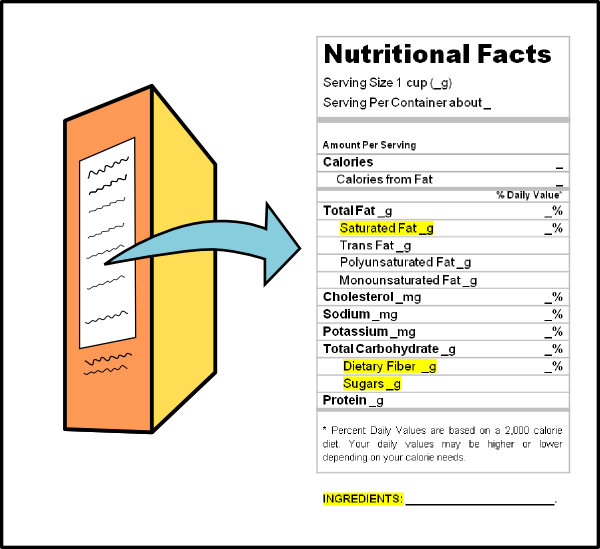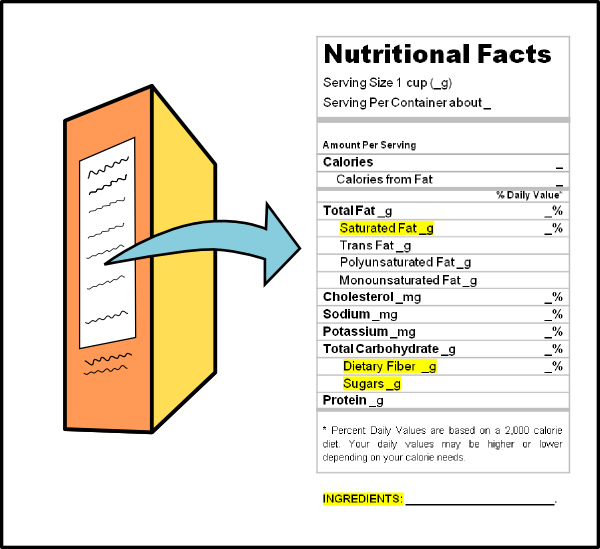- Look at the Nutritional Facts and Ingredients List
It is helpful and important to read the Nutritional Facts and Ingredients List when choosing food items. For cereals, you can compare basically the amount of sugar, the presence of whole grains and fiber, and sometimes the amount of saturated fat.
For Healthier Cereals, look for:
- Less Sugar
Most of the sweetened cereals have approximately 10g of sugar per cup. That’s like eating sugar of 4-5 mint candies every breakfast! Avoid words like Frosted, Honey, Cocoa, etc.
Choose cereals with less than 6g of sugar per cup. Less is Better.
- Whole Grains
Check if the whole grains are the major ingredient of the cereal. As the ingredients are listed by decreasing weight, it should be mentioned in the beginning of the ingredients list. Example of Grains are Oat, Corn, Wheat, Rice, etc.
Bran is also a good source of fiber, as it is the hard outer layer of cereals. It should be the main ingredient of the Bran cereal.
Some cereals make claims of being a good source of fiber and whole grains in front of the box, but remember to check how much sugar they have in it. The bad effects of high amounts of sugar surpasses the benefits of a small amount of fibers.
- Less or No Artificial Coloring
Although they are approved by FDA, there are still concerns about the link between artificial coloring and behavioral problems in children such as ADHD.
- Examples:
– Frosted Corn Flakes or similar:
In a serving of 30g (3/4 cup), there is less than 1g of fiber (made of milled corn – it is a refined grain) and 11g of sugar.
– Honey Nut Cheerios or similar:
In a serving of 28g (3/4 cup), there are 2g of fiber (made of whole grain oats) which are good, but a high amount of sugar of 9g.
– Froot Loops or similar:
In a serving of 29g (1 cup), there are 3g of fiber, but 12g of sugar and artificial coloring. It was made with a mixture of refined and whole grains, and the first ingredient is sugar. (So, whole grains are not the main ingredient of this cereal).
– Cheerios or similar:
In 28g (1 cup), there are 3g of fiber and 1g of sugar. Made of whole grain oats.
– Multi Grain Cheerios, Kroger Multi-Grain Toasted Oats or similar:
In 29g (1 cup), there are 3g of fiber and 6g of sugar. Made with a variety of whole grains.
– Kroger Wheat Puffs or similar:
In 17g (1 cup), there are 2g of fiber and 0g of sugar. Made of durum wheat.
- Healthy Tips
– Unsweetened cereals may taste too bland for some people, particularly kids. Mix a small portion of sweetened cereal with a large portion (a bag) of an unsweetened cereal! The less you add of the sweetened cereal in the unsweetened cereal bag, the less you and your family will consume sugar. Try to mix the cereals when you’ve just opened the bags because it will be more convenient than mixing the cereals in your bowl every morning.
– Adding milk to your cereal will reduce the taste of sweetness because it dilutes the sugar. So, Instead of adding more sweetened cereal, sugar, honey or etc., choose dried fruits high in fiber like prunes or fresh fruits. (Avoid raisins and dates because although they are dried fruits, they are too sweet with too little fiber.) You can also add dried fruits and nuts to your cereal bag.
Interesting articles:
How to choose a healthy breakfast cereal – Time
Dietary fiber: Essential for a healthy diet – Mayo Clinic
Sugared cereals: Should kids avoid at all costs? – CBS News
Sugary cereals: Which are the 10 “worst?” – CBS News
Share with us other Healthy Breakfast Cereals that you like or have found on the comment section below! Yum!
See you soon!




















